Note-taking is a timeless skill — essential for students, professionals, creatives, and lifelong learners.
Whether you’re trying to capture key ideas from a lecture or brainstorm project plans in a meeting, the ability to write fast and organize your thoughts is critical.
But in today’s fast-moving, cloud-connected world, traditional pen-and-paper notes often fall short.
That’s where smart pens come in. These innovative gadgets combine the comfort of handwriting with the power of digital organization, allowing users to record, save, search, and share notes with ease — anytime, anywhere.
In this article, we’ll explore what smart pens are, how they work, and why they’re transforming how we capture ideas in education, business, and beyond.
What Is a Smart Pen?
At first glance, a smart pen might look like an ordinary writing tool — sleek, compact, and familiar.
But under the surface, it’s a powerful piece of technology designed to bridge the gap between the analog and digital worlds.
It allows you to write by hand while instantly turning those handwritten notes into digital content you can store, edit, organize, and share.

A smart pen does more than write. It connects your pen strokes to the cloud.
Most smart pens use a combination of motion sensors, Bluetooth, pressure sensitivity, and sometimes optical tracking to capture what you’re writing in real time.
Some models require special dotted paper (embedded with micro-patterns to guide the pen’s position), while others can function on regular notebooks or digital tablets.
What truly sets smart pens apart is their ability to record and sync content as you write — whether you’re taking notes in class, sketching ideas during a meeting, or making to-do lists at home. Many models also include:
- Built-in memory to store notes even without a connection
- Audio recording features, allowing you to sync your writing with spoken words
- Handwriting-to-text conversion, transforming your notes into editable digital files
- App integration with cloud platforms like Google Drive, OneNote, Evernote, and iCloud
- Eco friendly
In short, a smart pen isn’t just a tool for writing — it’s a digital assistant designed to enhance your productivity while keeping the natural, tactile experience of handwriting.
Why Traditional Note-Taking Is Falling Behind
Handwriting has long been praised for helping us focus, memorize better, and express ideas creatively. But when it comes to speed, searchability, and modern workflows, traditional notebooks can’t keep up. Here’s why:
No built-in search
Paper notebooks don’t allow you to search by keyword. Finding that important quote or formula from two months ago? Not so easy.
Limited organization
Juggling multiple subjects or projects usually means carrying multiple notebooks — which easily become messy or misplaced.
No backups
Spill a coffee or lose your backpack, and your notes are gone for good. There’s no cloud recovery for physical paper.
Manual digitization
If you want to share or archive your notes digitally, you have to scan or retype them — wasting precious time.
Smart pens remove all of these limitations while keeping the natural, distraction-free writing experience intact.
How Smart Pens Work: The Technology Behind the Ink
Digital Sensors
Smart pens are equipped with sensors that track the motion and pressure of your writing. Some models also detect tilt and angles for more accurate sketching or calligraphy.
Companion Apps
Smart pens pair with mobile or desktop apps via Bluetooth or Wi-Fi. The app receives the data in real-time, storing your notes or converting them into text automatically.
Cloud Integration
Many smart pens offer cloud sync with platforms like Google Drive, OneNote, Dropbox, or Evernote. This makes your notes accessible across all your devices.
Smart Paper vs. Any Surface
Some smart pens, like the Livescribe, require special dotted paper. Others, such as the Neo Smartpen or Moleskine Pen+, also use coded paper.
Then you have models like the Rocketbook (with reusable notebooks) and reMarkable 2 tablets, which provide even more versatility.
Who Uses Smart Pens — And Why
Students
For students, smart pens are a dream. They can:
- Take handwritten notes while automatically recording the lecture
- Tap a word in their digital notes to replay what the professor was saying at that exact moment
- Organize notes by subject and share with classmates instantly
Professionals
In business settings, smart pens allow professionals to:
- Jot down meeting notes without opening a laptop
- Draw diagrams or flowcharts and send them to a team instantly
- Record voice notes while writing action items
Creatives and Designers
For designers, illustrators, and creatives:
- Smart pens allow sketching by hand and instantly digitizing their work
- They can edit, scale, and share drawings without scanning anything
- It’s a way to blend analog creativity with digital precision
Best Smart Pens in 2025
Livescribe Symphony
- Smart paper + audio recording
- Converts handwriting to digital instantly
- Syncs with OneNote and Evernote
- Great for students
Neo Smartpen M1+
- Compact design
- Works with standard notebooks
- Converts to text via Neo Studio app
- Excellent for professionals
Rocketbook Core + Pilot Pen
- Wipeable notebook pages
- Digitize and reuse endlessly
- Great value for money
- Eco-friendly choice
reMarkable 2
- E-ink tablet + stylus
- Feels like writing on paper
- Best for deep work and creative professionals
Limitations to Consider
Despite their many strengths, smart pens are not perfect:
- Battery life: Most require regular charging
- Paper limitations: Some require special notebooks
- Price: Good models can be expensive
- Learning curve: Apps and settings need some getting used to
However, for many users, these are minor trade-offs considering the time saved and productivity gained.
Smart Pens vs. Tablets & Styluses
You may wonder: “Why not just use a tablet and stylus?”
Key differences:
| Feature | Smart Pen | Tablet + Stylus |
|---|---|---|
| Cost | Lower | Higher |
| Writing feel | Pen-on-paper | Glass surface |
| Portability | High | Medium |
| Distraction-free | Yes | No (apps, notifications) |
| Reusability | Limited | High |
Each tool has its place, but smart pens are ideal for those who love handwriting and want a digital backup — without distractions.
Real-Life Example: How a Student Improved Grades Using a Smart Pen
Lucia, a university student in Brazil, struggled to keep up with her engineering lectures. She started using the Livescribe Symphony smart pen. Now, when reviewing her notes, she can tap a word and replay the professor’s exact explanation.
Her comprehension and retention improved, and her grades went up within a semester. Plus, she can now study on her phone while commuting.
The Future of Smart Pens
The smart pen market is expected to grow exponentially, thanks to:
- AI-driven handwriting recognition
- Better integrations with virtual assistants
- Smart scheduling based on written to-do lists
- Collaborative note-taking in the cloud
Soon, writing by hand will feel as powerful as typing on a keyboard — if not more.
Final Thoughts: Should You Invest in a Smart Pen?
Whether you’re taking notes in class, drafting ideas in a meeting, sketching diagrams, or writing your next big concept, a smart pen changes how ideas come to life.
It gives you the freedom of handwriting with the organization of digital tech, allowing you to stay productive, focused, and connected — all without ever opening a laptop.
This isn’t just a productivity gadget. It’s a tool for amplifying your memory, protecting your ideas, and streamlining your work.
So if you’re ready to upgrade your workflow — without giving up the feeling of writing on paper — investing in a smart pen might be the smartest move you’ll make this year.
